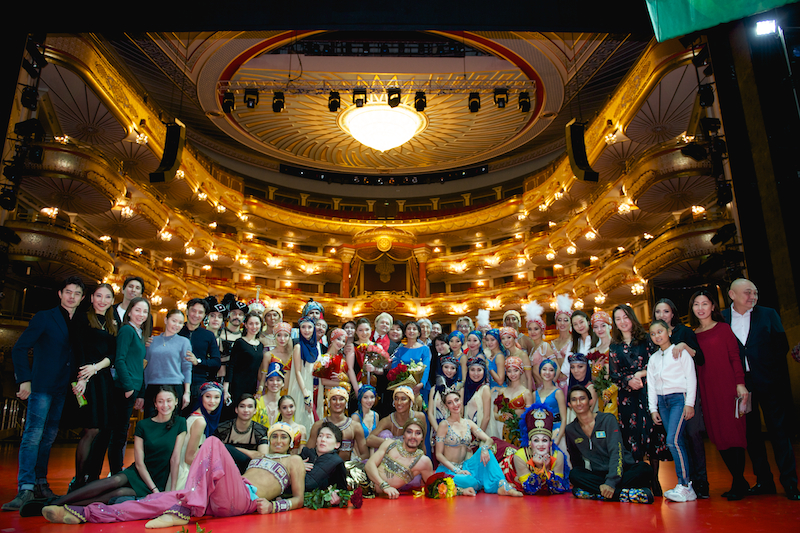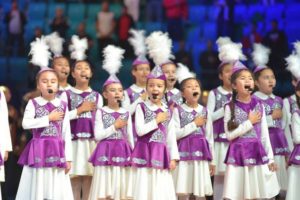Unique Ballets Chopiniana (Les Sylphides) and Scheherazade Were Added to the Astana Opera’s Repertoire
On November 30 and December 1, in celebration of the Day of the First President, the Astana Opera has made a gift to the residents and guests of the capital, presenting the premiere of one-act ballets Chopiniana (Les Sylphides) and Scheherazade by the outstanding reformer of choreographic art Michel Fokine. The productions were staged by ballet masters People’s Artists of Russia Altynai Asylmuratova and Andris Liepa.
The ballet premiere was held in celebration of the 20th anniversary of Astana, under the auspices of the Ministry of Culture and Sports of the Republic of Kazakhstan.
In the first part, the romantic ballet Chopiniana (Les Sylphides), striking with its artistic harmony, rare musicality and rich dance pattern, was featured for the audience. Clean lines captivated the viewers’ attention. Dancers created different shapes: some were like flowers, others were like geometric patterns. A poet’s dream world, where ethereal ballerinas fluttered around him, reigned onstage. Subdued blue-tinted lighting gave the production an even more romantic atmosphere.
Incidentally, the ballet Chopiniana (Les Sylphides) turned 110 years old this year, but thanks to its unique choreography it remains as relevant as ever. According to M. Fokine, he sought to “return the formal ballet dance to the moment of its highest flourishing”.
The Ballet Master A. Asylmuratova managed to accurately convey Fokine’s exclusive style of ballet; the master’s hand was felt in all the finest details: from the head turn or the look of the Principal Dancers to hand and feet positions.
The dancers demonstrated excellent musicality and synchronism of movements, which they worked out with the Assistant Ballet Masters – Honored Artist of Russia Konstantin Zaklinsky and Elena Sherstneva.
The stage was not filled with massive scenery; the hand-painted backdrop elegantly complemented the overall image. Alexandre Benois and Orest Allegri’s set and costume design were carefully recreated. Victor Carare was responsible for the sets. Arassel Dosmuratova made all the dresses in impeccable white color, and delicate pink wreaths completed the ballerinas’ costumes.
On different days, Yerkin Rakhmatullayev and Olzhas Tarlanov admirably performed the difficult part of the Young Man. Each of the dancers was able to convey the mood of dreaminess and feeling of love. The Honored Workers of Kazakhstan Madina Basbayeva and Aigerim Beketayeva presented bright, masterly Seventh Waltz equally well. Moldir Shakimova and Adelina Tulepova danced the Eleventh Waltz. Mariko Kitamura, Anastasiya Zaklinskaya performed the Prelude.
The multicolored ballet Scheherazade to the music of N. Rimsky-Korsakov’s symphonic suite, one of the composer’s best works, contrasted with the neo-romantic Chopiniana.
The music was not intended for ballet, but Michel Fokine heard melodies ideal for dancing in it. The choreographer took a liberty of reshaping the musical canvas.
Thus, the first part played the role of the overture, in which fairytale motifs and Eastern themes are heard. To this music, even before the dancers appeared onstage, the audience enthusiastically admired the painted backdrop, which filled almost the entire stage space. The depiction told a story about mysterious girls living in a castle, painted images of rich nature, the waterfall seemed to be offering its life-giving coolness, and the stork and the peaceful grazing animals created a serene mood. The lighting designer has set up the lighting in such a way that individual parts of the picture at times became more distinct, and then dissolved in a light haze.
After the overture the Music Director and Conductor Arman Urazgaliyev received well-deserved ovations, and afterwards the Maestro and brilliant musicians of the Astana Opera Symphony Orchestra, who demonstrated their excellence throughout the performance, received multiple rounds of applause. Kalamkas Jumabayeva and Bagdat Abilkhanov amazingly performed the violin solo.
The main theme of the plot of the ballet Scheherazade is the relationship between Sultan Shahryar and his beloved wife Zobeide. According to the libretto, the Sultan’s younger brother Shakhezman, convinced of female infidelity, advises him to go hunting. In the absence of the sultans, everything in the harem is given to love, and in the midst of the ‘festivities’ the sultan suddenly returns. He orders all of his concubines, eunuchs and slaves to be executed, and Zobeide stabs herself with a dagger. Shahryar cries over the dead body of his unfaithful, but much beloved woman.
People’s Artist of Russia Andris Liepa has repeatedly revived the M. Fokine’s ballets. The ballet master considers Scheherazade one of the outstanding choreographer’s best works. First and foremost, the ballet turned out to be organic, beautiful and definitely unusual. This is a plastique drama, where wild passion is hidden under the Eastern exoticism. According to ballet scholars, Fokine created a new plastique language in the Eastern style. Abandoning classical dance, pointe shoes and conventional gestures characteristic of the old ballet, he conveyed the action and feelings through poses and movements.
All the dancers masterfully performed their parts. Zhanibek Imankulov and Rakhmetulla Nauanov presented the role of Shahryar. Through skillful acting, the soloists did a wonderful character portrayal. Anastasiya Zaklinskaya and Honored Worker of Kazakhstan Gaukhar Usina performed Zobeide. Both dancers presented it in their own way: A. Zaklinskaya’s unreserved flexible plastique was impressive, and the artist was able to convey the image of an Eastern beauty. Gaukhar Usina channeled a lot of feelings into her heroine, her Zobeide turned out bright and emotional. Ildar Shakirzyanov and Yerlan Zhambulayev performed Shakhezman. Bakhtiyar Adamzhan gave a brilliant interpretation of one of the key parts – the Golden Slave. On the second day, Arman Urazov performed this role wonderfully. The Chief Eunuch – Olzhas Makhanbetaliyev, Rakhmetulla Nauanov. Odalisques – Moldir Shakimova, Adelina Tulepova, Yerkezhan Zhunusova, Mariko Kitamura, Seika Tonosaki, Nazira Zayetova.
Léon Bakst’s colorful set and costume design was carefully restored by Anatoly Nezhny and Anna Nezhnaya, who developed the Eastern theme in the ballet. (The costumes at the Astana Opera were revived by Elena Netsvetaeva-Dolgaleva). Bright set pieces: chandeliers, a staircase, carpets, ruffled ottomans and many other things did not let the eye get bored. The audience strived not to lose sight of any detail. Dazzlingly beautiful costumes adorned with gemstones, pearls and beads also played an important role.
The viewers did not let the dancers leave the stage for a long time, and thunderous applause and shouts of ‘Bravo’ filled the auditorium. As a general rule, the memory of such ballets lingers for a long time, and afterwards one wishes to re-watch them again and again. This is entirely possible, beacause now these productions have been added to the opera house’s repertoire.
The Minister of Culture Arystanbek Mukhamediuly and representatives of arts intelligentsia attended the performance.





